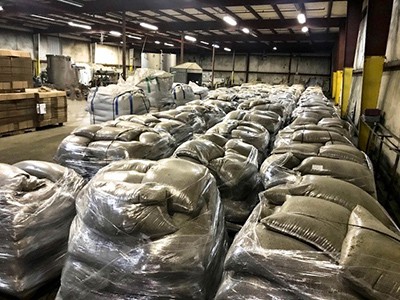Texas Prepares to Capitalize on Hemp Fiber, Grain Production Next Year
Marijuana Industry News June 19, 2020 MJ Shareholders
As Texas farmers submitted their applications for the 2020 growing season, Panda Biotech, a hemp fiber processing company based in the northwest part of the state, announced a plan to donate 60 tons of certified hemp seed to interested growers. The stock was quickly claimed, and executive vice president Scott Evans thinks that the company’s giveaway helped stoke the hundreds of applications that poured into the state capital this spring.
But there’s another side to what Evans is hoping to accomplish: Panda Biotech will work with Texas A&M AgriLife Extension to conduct a research project this year (and in years to come).

Courtesy of Panda Biotech
“Our whole play here is we want small acreage, but as many different soil types, regions and growers,” he says. “We want a widespread set of data. So, more people on fewer acreage is better for our data report.”
The hemp seed in this project is a Chinese variety grown primarily for fiber production. With Panda Biotech’s resources supporting a broad swath of the state this year, the plan is to accelerate the market infrastructure needed to get hemp fiber off the ground in the U.S.
“But along with that, we’re encouraging people to experiment with different varieties,” Evans says. “That information can be submitted and will be put into our final report. We’re working with Texas A&M AgriLife Extension. They will be helping us collect the data and form the final summary at the end of the growing season. We will then share for free with all the participants in this program.”
The research will focus on vital inputs: planting rates, seeds per acre, row spacing, planting depth, fertility rates, soil nutrient levels and pest problems.
The hemp varietal trials follow decades of public-sourced research into “wheat, grain sorghum, corn, sunflowers and soybeans, as well as other crops,” according to the school. Calvin Trostle, Texas A&M AgriLife Extension Service agronomist and statewide hemp specialist, said: “We will seek a balance between a bare-bones approach vs. an intensive assessment of hemp variety growth and performance.”
Whatever data comes out of this trial run will help set a foundation for next year, when it’s expected that more states will fall in line with the USDA’s impending final rule on hemp regulations. (Texas received its own USDA approval in January.)

Texas Department of Agriculture
“Texas, as you know, is a big state and there are a lot of different climates within the state alone,” Evans says. “A big part of the seed disbursement is we’re allowing everybody in the state to have access to it—not just people near our facility—because we want to see the data from everywhere and find out what’s the most ripe and fertile growing regions for him within Texas.”
Based on weather patterns and seed distribution, Evans was hoping that most farmers would get their seeds in the ground sometime in mid- to late-May, though he expects to see some variability among hemp growers’ data.
This is cotton country, after all, and the springtime tends to run dry. “Getting this seed out late has kind of a benefit where we want some people to experiment with later planting dates,” he says. Last year, Texas farmers grew 5.25 million acres of cotton—just a shade of 50% of total U.S. output.
Evans and others in the state, like Texas Agricultural Commissioner Sid Miller, hope to see hemp embraced as a business boon for farmers in need and for a consumer marketplace interested in more sustainable products. (When the 2018 Farm Bill legalized hemp production in the U.S, Miller said: “This is the big leap forward we’ve all been waiting for.”)
“I see no reason why they can’t grow a million acres of hemp,” Evans says. “And we’re not looking at this as any sort of replacement. This is a rotational crop. There’s a lot of benefits from growing hemp for your soil. So, maybe you grow your cotton crop two years and then you throw a hemp crop in there.”
To get hemp farmers up to speed with where the market is headed, Panda Biotech is building a decortication and processing facility that will offer a natural outlet for a commodity market that appears otherwise saturated in the U.S. This is why Evans suggested small acreage for the crop this year: Keep expectations low, develop the research and then take stock of what a Texas hemp fiber market might look like in 2021 and beyond.
He points out, too, that being able to process 130,000 tons of hemp biomass is just the sort of thing that provides a certain peace of mind for growers who might not know yet where to sell this newly legal crop.
Kenneth McAlister is a hemp grower who figured he’d throw his hat in the ring this year.
“Biggest thing is going to be to learn what we can and can’t do with [the hemp crop],” he says from the seat of his combine on his north Texas farm. “Nobody in the area has any idea exactly of what we can and can’t do with it.”
He got his Panda Biotech seeds in the ground in early June, citing the dry spring in his part of Texas. This year, McAlister is growing 32 acres of hemp with an eye toward fiber processing. He says he can see which way the wind is blowing with demand for hemp fiber—and hemp-derived plastics, even—and it’s a matter of taking a shot at growing it on his land. “I’m looking at what I can do to rotate something different on the ground,” he says, referencing his wheat and cotton crops, “and help pull some of the nutrients up or break the soil a little different.”
It’s a learning curve for so many farmers in Texas and elsewhere. That’s the whole thesis behind Panda Biotech’s move.
“A big thing here is going to be finding cured genetics, seeing how they respond to this climate and then improving upon those or crossbreeding those to find varieties that are suited for that region and also for fiber production,” Evans says. “I’ve been in the industry for number of years, there was medical cannabis, recreational cannabis, and then it was CBD. But really the true, scalable commodity ag models are in fiber and grain. We see a lot of potential for that in America. And that’s why we’re going with such a large-scale facility, because such as in commodity ag, it’s all about slimmer margins and higher production numbers.”
MJ Shareholders
MJShareholders.com is the largest dedicated financial network and leading corporate communications firm serving the legal cannabis industry. Our network aims to connect public marijuana companies with these focused cannabis audiences across the US and Canada that are critical for growth: Short and long term cannabis investors Active funding sources Mainstream media Business leaders Cannabis consumers









